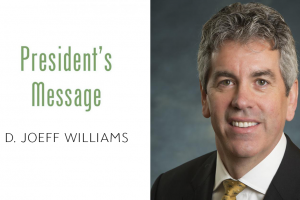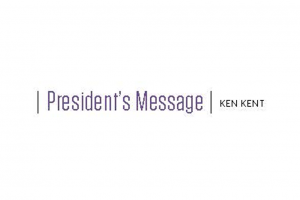By Ken Kent
For employers of actuaries, their employees’ membership in actuarial organizations provides clear and tangible benefits. With more than one actuarial organization in the U.S., it is important that employers understand the value and reasoning for supporting their actuaries’ individual, and often, multiple memberships.
Most employers “get it,” and gladly pay the dues for those organizations their actuaries belong to. They can appreciate the perspective each of the actuarial organizations provides in meeting the needs of their actuaries and appreciate the different values each organization membership brings in terms of the business and quality work product of actuaries. Membership in the American Academy of Actuaries (the Academy) specifically provides value for actuaries from the availability of professional standards, a code of conduct, continuing education or the many other benefits offered, as well as dedication to ensuring the value of the U.S. actuarial profession.
For those employers who are unclear about the benefits and opportunities that Academy membership provides for their actuaries—and even for those employers who provide full support—I provide the following rationale for the financial support of their actuaries’ Academy membership.
To support the necessity for membership in multiple actuarial organizations, and especially in support of membership in the American Academy of Actuaries (for which I must claim I have an obvious bias), it is important to first look at the substantiating actuaries as members of a profession, and the different roles supported by the actuarial organizations based in the U.S.
For any common practice to be recognized as a profession, it is critical that it be recognized and trusted by the public. Consider any profession and it is clear the public’s trust in the ability of a profession’s members is fundamental. If the public does not trust the work performed by a group of people performing a common line of work, they cannot easily call themselves a profession, and they cannot garner the greater financial value for the individuals in that line of work or for their employers. The public, including employers, has definite expectations for what it means for a line of work to be worthy of their trust and recognized as a profession. In defining any profession, there are five commonly recognized criteria that include:
- A unique, specific, detailed and specialized body of education and knowledge;
- An ethical standard and code of conduct applicable to all members of a profession;
- Well-defined qualification requirements in demonstration of the education and commitment to the work and ethical standard in their area of practice;
- An obligation to conform to a body of professional practice standards; and
- A robust disciplinary process that adjudicates the adherence to the ethical, qualification, and professional practice standards.
Having these criteria offered, as well as dedication to ensuring the value of the U.S. actuarial profession. not enough. They must be continually reviewed, and all members of the profession must be held accountable for their work product and conduct in accordance with them as practices continually change.
These criteria, coupled with the profession’s self-regulation, are the foundation of public trust and assure the actuarial professional’s value to employers, directly owing to an actuary’s multiple organizational memberships. The value of self-regulation cannot be underestimated because in its absence is a fully regulated actuarial practice devoid of innovation and the intrinsic value of actuarial judgment.
The Casualty Actuarial Society, the Society of Actuaries, and the Joint Board for the Enrollment of Actuaries are each essential credentialing bodies that provide assurance of criterion No. 1. Their syllabi represent the vast extent of skills and applied knowledge that an actuary must achieve to obtain their respective credential. Maintenance of membership in the appropriate credentialing organization(s) is essential for continued use of the respective credential that reinforces demonstration of mastery of the material through rigorous examination processes.
Membership in the American Academy of Actuaries is distinct and necessary to support the other defined professional responsibilities (i.e., criteria Nos. 2-5) that the public, including employers, demands of actuaries to remain self-regulated as trusted professionals. Membership is open to U.S. actuaries who not only have achieved the appropriate credential but also can demonstrate sufficient knowledge and understanding of basic actuarial principles as well as knowledge of U.S. laws and regulations relevant to their line of practice.
Independently maintaining and regulating this body of professional responsibilities within the profession is the foundation for all the work that the Academy does. Satisfying criteria Nos. 2 and 3, the Academy oversees:
- The Joint Committee on the Code of Professional Conduct (the Code)—This is the committee that last drafted the current version of the Code that was adopted by all five of the actuarial organizations in 2001 and represents the ethical standards of practice and conduct that almost all U.S. actuaries are bound to. (Actuaries who are only Enrolled Actuaries are bound by a code of conduct specifically defined in regulation).
- The Committee on Qualifications—This Academy committee oversees the current requirements to issue statements of actuarial opinion and determines the criteria for an actuary to be sufficiently qualified to issue such opinions across various lines of actuarial work in the U.S.
Finally, satisfying criteria Nos. 4 and 5, the Academy provides the organizational structure and the administrative support for two separate and independent boards, the Actuarial Standards Board and the Actuarial Board for Counselling and Discipline.
Because actuarial work typically can affect hundreds, thousands, or even millions of people, the Academy’s activities maintaining the public trust extend beyond these minimum criteria that merely define and regulate a profession. The Academy serves an essential role as an organization that the public and policymakers can turn to that is not encumbered by any outside interests or bias. Our work as a totally independent organization dedicated exclusively to the U.S. actuarial profession and the U.S. public addresses emerging actuarial-based issues that impact the public and provides unbiased support, analysis, and research to inform public policy debates and the relevant public stakeholders and decision-makers.
The Academy’s constant and dynamic interactions with those who represent the public improve the public trust, the profession, and the agility and knowledge level of individual professional actuaries who are members, and especially those who are Academy volunteers. Many members participate in the Academy’s public policy activities, and all are continually informed of these activities as a member benefit—making them better professionals and increasing their value to employers and the industries they represent.
This work is essential, and the Academy is focused in many ways on preserving the profession’s self-regulated status through interacting with policymakers and responding to various stakeholders’ needs. This work directly benefits employers by supporting the value of their actuaries’ work and the underlying sustainability of their industry. The public in turn transfers their trust of the actuarial profession to employers who employ them. The Academy’s dedication through volunteers in production of unbiased work product also benefits employers by providing content to maintain a level playing field. The practice councils and their committees address issues of practice head-on, such as uncovering and discussing bias and inequities that can be found in financial security industries designed to serve the public.
The actuarial profession and the professionals who retain Academy membership—all of whom serve employers, clients, and publics unencumbered by regulatory oversight—benefit from this work of the Academy, Academy staff, and the over 1,200 volunteer actuaries.
The Academy’s members, staff, and volunteer members also provide the highest level of support to satisfying continuing education and the dual professionalism and public policy needs of the U.S actuarial profession. They do that through publications and offering inexpensive access to live webinars as well as access to all prior webinar archives through recorded media. The Academy provides content to actuarial clubs, universities, employers and other actuarial organizations, as well as “affinity groups” supporting under-represented segments of the population in the profession. In this way, the Academy is supporting regional actuarial groups and focusing energy in development of a pipeline for supporting future actuaries.
So it is well understood why most employers of actuaries support the American Academy of Actuaries, by way of paying membership dues for all of their credentialed actuaries—and they often proudly proclaim this position, as they should. For those employers that don’t make membership mandatory and provide for their portion of the cost of services performed by the Academy on their behalf, I hope I helped identify that in the broader financial scheme of employing actuaries and benefiting from their knowledge and professional standing, the additional cost of support for the constant maintenance of the public trust and preservation of self-regulation provides the rationale for all employers of actuaries’ support.
It is important for the U.S. actuarial profession that employers understand that they have a full and vested interest in supporting the actuaries they employ and supporting the value of the actuarial profession as trusted advisers to clients, companies, and all stakeholders in sustainable and affordable financial security systems for our nation through the commitment of the work of the American Academy of Actuaries.
Thanks for listening.





